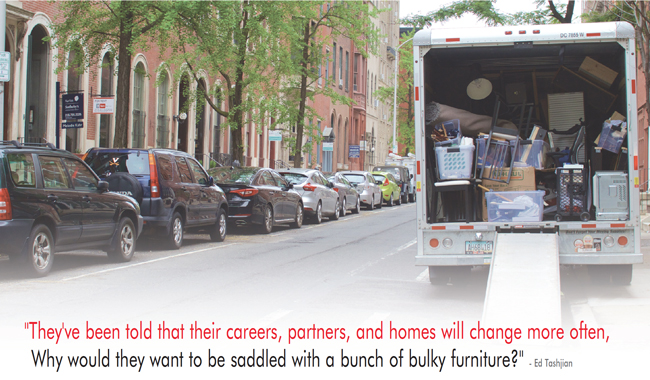
Ed and Bill debate
the many ways that millennials are likely to change as they reach their peak
furniture buying years.
Editor’s Note: Here's more from Furniture World's point/counterpoint duo Bill Napier and Ed Tashjian, having previously debated topics including: celebrity licensing, digital advertising overload, the millennial myth, whether or not furniture brands matter, the future of furniture markets, the future of independent reps and the top marketing strategies for 2020. See all of their commentary
here.
POINT: Ed Tashjian
As millennials mature and come of age, will they change in ways that baby boomers did, and how might this change affect the furniture industry?
Yogi Berra had it right, “The future ain’t what it used to be.” Of course, millennials will mature differently than baby boomers did, and this will have a dramatic effect on the furniture industry. And unless you are prepared, get ready to follow the same path as Kodak, Nokia, Myspace and Blockbuster.
Let me be clear. People did not stop taking pictures, buying cell phones, using social media, or watching movies. In fact, all of those behaviors increased exponentially. It is how and where they did it that changed. Likewise, one of the beautiful things about the furniture business is that people will always need a place to sleep, eat and watch TV. It’s not the need for furniture itself that will change, but rather what, how and where people buy it. If you can take advantage of disruption rather than being a victim of it, the future is bright. If you think like Kodak who was in the film business, you are toast.
First, allow me to define the parameters of what we are writing about. Millennials are currently 22 to 37 years old, and we are imagining the next 25 years of their furniture buying behavior, so between 2020 and 2045. There are about 71 million millennials now, which is approximately equal to the number of current baby boomers. Millennials will soon become the largest generational cohort.
Some things are obvious, but others are not. There isn’t a trend that isn’t driven by lifestyle change. If you understand how lifestyles are changing, it will always lead you to future trends. You can test this by taking any current trend and tracing it back to the lifestyle that spawned it.
Let’s look at the obvious ones first and translate how they may affect future behavior. Then we will look at some of the less obvious ones, but just as impactful.
Millennials are
currently 22 to 37 years old, and we are imagining the next 25 years
of their furniture buying behavior, so between 2020 and 2045.
- Ed Tashjian
Urbanization
Approximately 85 percent of Americans now live in urban areas. The trend line is steep, and it is predicted that 95 percent will live in urban areas by 2040. This is consistent with most of the world. Barring some cataclysmic event, this is inevitable.
The implications are staggering. Urban areas are more congested, and as a result have less space. The consequence for furniture makers and retailers is that smaller scale and multi functionality have a premium value. Pieces must fit through doors and on elevators. New buildings are likely to be high rise and have more modern and contemporary architecture. Deliveries will become increasingly difficult and will more often than not come by UPS rather than a store delivery truck. That means it needs to be designed to be easily assembled in the home. White glove will be usurped by “I assembled it myself, and damn proud of it.”
Renting vs. Owning
The burgeoning rental market is both peril and promise. There are going to be a lot fewer of those McMansions that were once the mainstay of suburban furniture retail stores. There will be fewer rooms to furnish. Fewer second and third bedrooms. Fewer formal living and dining rooms. People will entertain in their homes less often and in smaller groups. They will probably be more mobile. Again, furniture will need to be smaller scale and multifunctional. Occasional tables will need to nest. Console tables will need to expand into dining tables. Functional storage will be mandatory. The sofa will also need to be a “spare bedroom.”
And renting is not exclusive to apartments. Some of the fastest growing channels for furniture are in rent to own. And now it’s moving upscale. Check out www.livefeather.com positioned as “High-quality furniture delivered & assembled in less than a week that can change as your life changes.” If you love it, you can buy it. If not, you trade it in for something else.
Clicks and Bricks
By the end of the next decade, I estimate that more than a third of all home furnishings will be bought over the Internet. If you don’t have an e-commerce strategy, you should start planning your going out of business sale now.
Believe me, I understand the resistance. It doesn’t make sense to me, but you can’t argue with the facts. The Internet is generally more expensive for branded items. You can’t see it, touch it, sit in it or imagine the scale. You can’t kick the tires, lift the cushions, test the drawers, ask pointed questions of an experienced salesperson for guidance. Who in the world would buy a sofa online? It seems totally illogical.
Just as Casper
and Nectar disrupted the bedding industry with a bed in a box, there needs
to be more sofas in a box that assemble and disassemble just as easily.
- Ed Tashjian
I’m embarrassed to say, my very own daughter who is furnishing her first apartment with all of my furniture knowledge and 30 years of industry connections, she was more comfortable buying from Wayfair. It took her less than 10 minutes to pick it out. She ordered it on Monday and was sitting on it Friday. By far, the hardest part was getting me to agree to pay for it and overcoming my arguments that it was probably junk, would not be that comfortable, and that she would not keep it for more than a few years. She explained that she had no intention of keeping it more than a few years. She did not see exactly what she wanted in the store, and did not have the patience to special order. She had no desire to haggle with a salesperson or wait for a delivery. The promise of an easy transaction and immediate gratification was far more powerful than the details of fine craftsmanship and finishing. It is bittersweet for me to report that this story has a happy ending. She loves what she bought.
Now, let’s look at some trends that are less obvious, but will be just as impactful.
Core Values

There are fundamental changes in core values. Furniture is far lower on the list of priorities of these generations. I don’t need any research to tell me that the most important purchase for any millennial is a smart phone. And, it costs about the same as a sofa. If they lost their sofa and their cell phone on the same day, it doesn’t take a genius to know which one would be replaced first. Entertaining at home is less important. These folks like to go out and meet in public restaurants and bars. It goes hand-in-hand with a lifestyle of being more urban, renting versus owning, and living in smaller spaces. They are more likely to spend on experiences rather than things.
There are deep or social changes that will have even more lasting impacts.
The institution of marriage continues to change. Only half of adults today are married. This is a substantial decline from the boomer generation. Cohabitation among married partners has increased and the share of U.S. adults living without a spouse or partner has also increased. When people are not married, they tend to make different purchase decisions. It is either his or hers. How finances are shared is fuzzy and different in every relationship. This makes major purchases such as furniture more complex.
They are also delaying having children. This is one of the reasons that homeownership is declining. The rate of homeownership for couples with children declined to 70.1 percent in 2016 compared to a rate of 72.9 percent in 2013, which is down from a peak of roughly 79 percent in 1998.
At the risk of sounding sexist, most men think differently about home furnishings. They want comfort and practicality. Women drive most of the style decisions.

Immediacy
I want it now and I don’t expect to own it for a lifetime. This is a fundamental shift from boomers whose parents grew up during the depression and inculcated different values. Relatively speaking, consumers today are impatient. They want what they want, and they want it now. Anywhere that boomers gather you can hear this lament about their children. Regrettably, they don’t want or even value their parent’s furniture. They don’t care how long it lasts if it’s something they don’t want. We thought they would covet it. They hate it. It reminds them of being old.
Occasional tables
will need to nest. Console tables will
need to expand
into dining tables. Functional storage will be mandatory. |
They have been told that their careers will change more often, their partners will change more often, and their homes will change more often. Why would they want to be saddled with a bunch of bulky furniture?
The implications are that furniture must be designed to be more mobile. RTA needs to evolve from the primitive IKEA to elegantly designed easy to assemble and disassemble items. Just as Casper and Nectar disrupted the bedding industry with a bed in a box. There need to be more sofas in a box that assemble and disassemble just as easily. I suggest you check out bundleliving.com for an innovative solution that checks all the boxes.
And this won’t be just for ecom. Stores are going to want to carry these in inventory. They need to fit in the back of an Uber XL. The customer gets immediate gratification, and the store saves a $200 delivery charge. A legitimate and believable discount.
Rising Income Inequality
The evaporation of the middle class will have an enormous impact on all buying behavior. First, there will be far less disposable income for home furnishings. Next you may not have the kinds of efficiencies of scale that will support smaller stores. Only 10 percent of the U.S. population is making more than $100,000, and the median income is around $40,000.
This means that as time goes on there will be more demand for less expensive furniture. The fixed costs of running the store—rent, labor, insurance etc.—will stay the same or will go up, but the average transaction amounts will decline. This means you will need to sell a lot more units or do it in a smaller space with fewer people. Technology will help, but it will still be a challenge.
AI and Automation
In the next decade augmented reality and automation will change the way we manufacture and sell furniture. The ever-changing politics of globalization will affect where we source parts and raw materials. If history repeats itself, many of the stalwart retailers of today will be replaced by new marketing, merchandising and delivery concepts we haven’t yet dreamed of. Channels of distribution will change, materials will change, and living spaces will change. Two-thirds of C-suite executives believe that 40 percent of Fortune 500 companies will no longer exist in 10 years’ time due to digital disruption. I don’t know why furniture would be any different.
Some things probably won’t change very much, if at all.
Designs
It is impossible to predict what differences in design the next 25 years will bring. But the past is often prologue. Even today, some of our design inspirations are hundreds of years old. Nearly every manufacturer still makes a version of a Klismos chair which first appeared somewhere between the 8th and 6th century BC. When we look through the ads in old magazines we laugh at the changes in hairstyles, gawk at changes in automobiles, and marvel at the evolution in microprocessors and computers. But the silhouette of the furniture still looks pretty much the same. The shape of a sofa, bed or table are unlikely to change 50 years from now. Size, scale, materials, and how they are sold will all change, but the silhouettes most likely will not.
Human Nature Won't Change
Our survival depends
on whether we
remember what
business we are really in
or fall into what I call
the Kodak trap of
thinking we are in the film business. |
If Shakespeare's plays written in the 1600s still resonate today, they will, 50 years from now, too. People will still fall in love, break up, and get back together. Kids will still fight with each other and become as thick as thieves when they mature. We will continue to have bouts of loneliness and sheer joy, and fight with our partners over the same stupid things. We are essentially stone age troglodytes, with ever improving living standards.
I have always thought that furniture was a great business. Even if we are going from place to place in solar powered flying cars, there is a high degree of likelihood that we will still be sleeping in beds, sharing meals around dining tables, and sitting on a comfortable chair or sofa to watch the next generation of sporting events. Through time immemorial families will be feathering nests and to create a cozy haven reflecting their personal lifestyle and personality. It is an inexorable human drive extending from the Flintstones to the Jetsons.
In sum, our need for furniture will not change much. But the business will change dramatically, driven by lifestyle changes among the millennial generation. Our survival depends on whether we remember what business we are really in or fall into what I call the Kodak trap of thinking we are in the film business. No, the future ain’t what it used to be. The best we can do is to observe and adapt to the obvious trends, and hope we catch those that other retailers and brands will miss. Be careful who you listen to.
COUNTERPOINT: Bill Napier
I’m not optimistic, but somewhat hopeful.
My take on Ed’s POINT, if you read between the lines, is … Be scared, VERY scared. If you think millennials will change in the next 10 years, try bowling with three pins and without the ball and let me know how that works for you. I’ll add to some of Ed’s POINT and of course, add my own RANTS to this column.
The Future Ain’t
What It Used To Be
How true and how sad.
Renting vs. Owning
Owning a “home” is not the American Dream it used to be. I live in Minneapolis, and OMG apartment construction is out of control. I’m not talking about small buildings, I’m talking about massive multi-building apartment complexes taking up acres of space, and the rents on these units cost more than a mortgage, in most cases.
Case in point: I have a friend, who lives in a huge complex near the MSP Airport. It has all the amenities, workout rooms, a coffee shop, juice bar, etc. Her apartment is approximately 500 sq. ft. The living room and kitchen are in the same room. A small galley kitchen on one wall and the living room barely fits two sofa-like chairs and a stool. She pays $1,650.00/month. A steal for New York or San Francisco, but for Minneapolis... OUCH!
All these new buildings, and even older houses/apartments for rent in the cities are averaging around $1,300-$2,500/month. The lesser costs being one-bedroom, the higher costs, 2-3 bedrooms.
Doing the math, you can quickly understand that these costs, plus utilities, food, entertainment, quickly put this group out of the housing market, because they can’t afford to buy anything and here’s why...
The Truth About Millennials as Viable Consumers
Twenty-seven percent
of millennials say they have no close friends
and 30 percent say they have no best friends,
so why would they need home furnishings, other than the very basics? |
The average MILLENNIAL has a credit score of 625, the worst of any generation, ever, but it’s 687 for Gen X (35-49), 739 for baby boomers and the Greatest Generation (together, those generations include everyone older than 50).
Think about this, people over 50 buy 50 percent of everything, to the tune of $3.2 trillion dollars, yet receive less than 5 percent of your marketing dollars and guess what, 76.2 percent of households age 50 and over, and 78.7 percent of households age 65 and over—own their homes. With the aging of the baby boomers, 63 percent of U.S. homeowners are now at least age 50 and 31 percent are at least age 65.
The current savings rate for millennials is negative two percent. Not only aren't millennials saving any money, but they are also actually spending a good bit more than they are earning every month, on entertainment, their precious $5 cup of coffee and more. (WHY, would you spend your marketing dollars on this group)?
Over 30 percent live at home with mom and dad. My son was in town this week and when I asked him if he visits his old friends from high school, he said that he doesn't. When I asked him why, he said they still all live at home and he doesn't want to visit their parents. OUCH
According to the Pew Research Center, nearly four out of every 10 U.S. households that are led by someone under the age of 40 are currently paying off student loan debt, which averages over $36,000, paying on average, $203/month. Add that to the cost of living and renting an apartment! The number paying off debt is an astounding 40,000,000 people, with a delinquency rate of over 11 percent.
These costs,
plus utilities, food, entertainment, quickly put this group
out of the housing market, and here’s why.
- Bill Napier
Their Debt Won't Go Away
Today, millennials earn 20 percent less than their parents did at the same age, and only about one in three millennials under the age of 35 owned a home as of the end of 2018, according to the U.S. Census Bureau. That's eight to nine percentage points lower than previous generations' homeownership rates at ages 25 to 34, according to research from the Urban Institute's Housing Finance Policy Center.
To Ed’s point, they are renting, buying smaller scale furniture and less of it. That's why the industry’s largest player has entered the RTA business with a big bang.
Core Values

Social Media has devastated the social lives of a majority of millennials.
If you Google: “Millennials have no friends”, you’ll find, according to YouGov, that 22 percent of the millennials in a recent survey report that they have zero friends.
It gets even worse. Twenty-seven percent say they have no close friends and 30 percent say they have no best friends.
Let's do the math! 15,620,000 – 21,300,000 of this generation have no friends, close friends or best friends, so why would they need a home, or home furnishings, other than the very basics?
And in my opinion, they are the most guarded and isolated generation in history. Parents who tried to guard them against the so-called evils of the world inadvertently created the “safe-space” generation. Rather than educating them on the realities of life, many developed a privileged mindset. If they want it, they feel that they deserve it. And after they get it, they need to replace it because they saw/heard something in their “feed”. Obsolescence is a buzzword and it's important to stay cool and "relevant" in this generation.
Rising Income Inequality
I blame this on our education system, PERIOD!
Our education system teaches, or rather propagates, social justice instead of life values. This starts in our middle schools and high schools. The Education Trust conducted a study of outcomes for recent high school graduates and found that while 82 percent were graduating, only around 8 percent were actually ready to take on college-level courses.
The obvious result of this is the “dumbing down” of our future generations. Colleges have to make their courses easier in order to feed their financial juggernaut – enrollment. The obvious result of this is that most college educations are less relevant, with students failing to learn the basics needed to thrive, improve themselves and engage with individuals and society.
Rather than get out and discover the world, make new friends and engage with “life”, they engage with electronic communications, and false realities.
Clicks and Bricks
To Ed’s point, they are renting, buying smaller scale furniture and less of it.
That's why the industry’s largest player has entered the RTA business with a big bang. |
At this point I will temper my remarks by adding that my kids are all millennials and they don’t have the negative profile I’ve described. Many don’t. But to Ed’s point, they do buy everything online. My daughter has three kids and every time I visit, the boxes are in the hallway, and tons of them waiting for disposal in the garage. If you don’t embrace this online generation, like Ed says, start your going out of business sale.
By 2021, 36 percent of all home furnishings will be purchased on-line. In 2021, over 2.14 billion people worldwide are expected to buy goods and services online, up from 1.66 billion global digital buyers in 2016.
Amazon is set to clear $258.22 billion in U.S. retail sales in 2018, according to eMarketer's figures, which will work out to 49.1 percent of all online retail spend in the country.
If these statistics don't convince you, maybe you like to bowl with three pins and forget your ball.
My Conclusion
No one aspires to be indentured to renting a space, living in an uncomfortable space and being lonely. Maturity is something people obtain at different times in their lives. Some people just “get it” at an early age, many others later in life, and others not at all.
I hope and pessimistically believe that this generation will change, mature and come of age.
I hope and want to believe this will happen, not only for the sake of my friends in the furniture business, but because living a life of mediocrity and hope, does not deliver personal fulfillment, which is innate in every human being.
About Ed Tashjian: Tashjian Marketing provides senior marketing leadership to the Home Furnishings Industry. It specializes in business analytics and in helping its clients to segment the market, define and communicate a sustainable differentiated value proposition. Get more information at
www.Tashjianmarketing.com or call Ed at (828) 855-0100.
About Bill Napier: Bill is Managing Partner of Napier Marketing Group. He has been the chief marketing officer of several small, medium and large companies throughout his career, most notably Ashley Furniture Industries. Bill is also a featured writer and speaker in the retail industry. His passion is to help retail brands and brick and mortar retailers grow their businesses by creating, guiding and deploying successful marketing B2B/B2C solutions integrating traditional marketing with the web/social media. He has demonstrated this with his FREE website www.social4retail.com with hundreds of articles and “how-to” strategies for retailers and brands. Reach Bill at:
billnapier@napiermkt.com or 612-217-1297.
See all of Bill and Ed's Point/Counterpoints at
https://www.furninfo.com/Series/Debate/57.
Furniture World is the oldest, continuously published trade publication in the United States. It is published for the benefit of furniture retail executives. Print circulation of 20,000 is directed primarily to furniture retailers in the US and Canada. In 1970, the magazine established and endowed the Bernice Bienenstock Furniture Library (www.furniturelibrary.com) in High Point, NC, now a public foundation containing more than 5,000 books on furniture and design dating from 1620. For more information contact editor@furninfo.com.